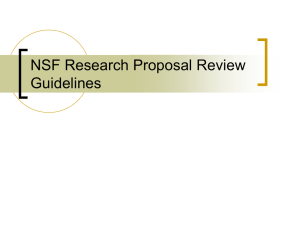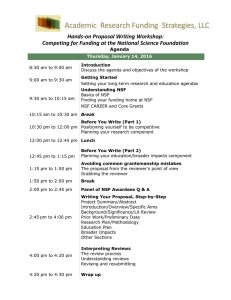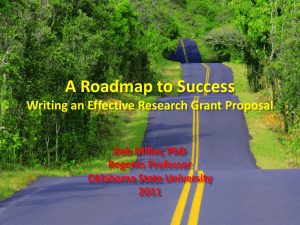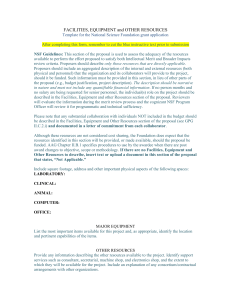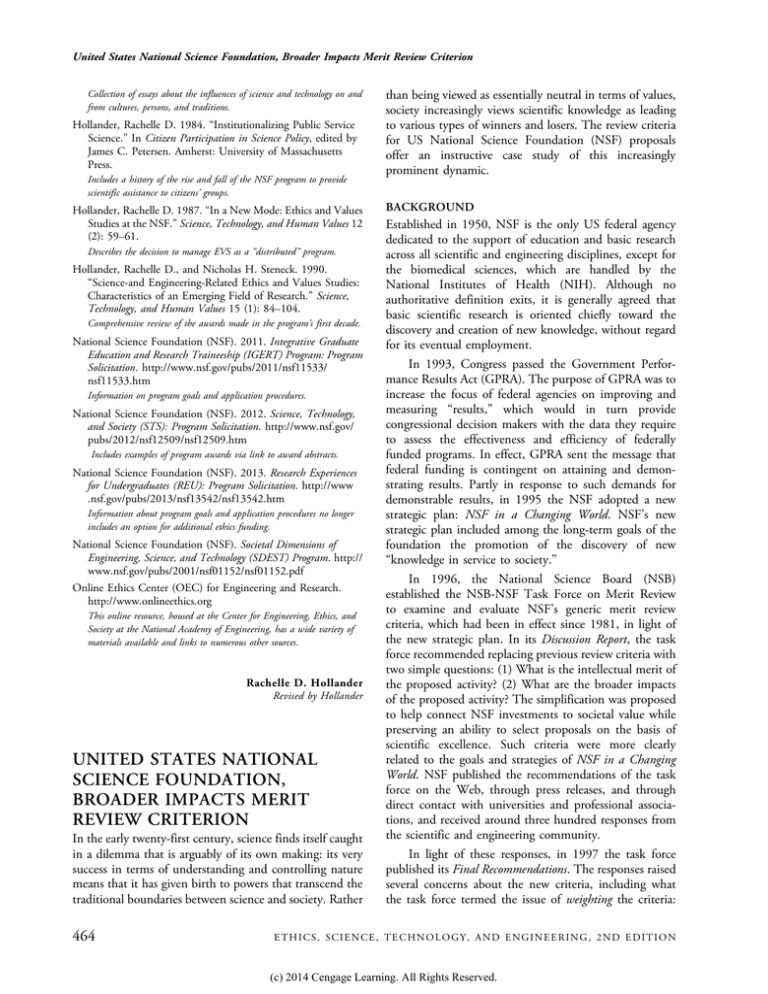
United States National Science Foundation, Broader Impacts Merit Review Criterion
Collection of essays about the influences of science and technology on and
from cultures, persons, and traditions.
Hollander, Rachelle D. 1984. “Institutionalizing Public Service
Science.” In Citizen Participation in Science Policy, edited by
James C. Petersen. Amherst: University of Massachusetts
Press.
Includes a history of the rise and fall of the NSF program to provide
scientific assistance to citizens’ groups.
Hollander, Rachelle D. 1987. “In a New Mode: Ethics and Values
Studies at the NSF.” Science, Technology, and Human Values 12
(2): 59–61.
Describes the decision to manage EVS as a “distributed” program.
Hollander, Rachelle D., and Nicholas H. Steneck. 1990.
“Science-and Engineering-Related Ethics and Values Studies:
Characteristics of an Emerging Field of Research.” Science,
Technology, and Human Values 15 (1): 84–104.
Comprehensive review of the awards made in the program’s first decade.
National Science Foundation (NSF). 2011. Integrative Graduate
Education and Research Traineeship (IGERT) Program: Program
Solicitation. http://www.nsf.gov/pubs/2011/nsf11533/
nsf11533.htm
Information on program goals and application procedures.
National Science Foundation (NSF). 2012. Science, Technology,
and Society (STS): Program Solicitation. http://www.nsf.gov/
pubs/2012/nsf12509/nsf12509.htm
Includes examples of program awards via link to award abstracts.
National Science Foundation (NSF). 2013. Research Experiences
for Undergraduates (REU): Program Solicitation. http://www
.nsf.gov/pubs/2013/nsf13542/nsf13542.htm
Information about program goals and application procedures no longer
includes an option for additional ethics funding.
National Science Foundation (NSF). Societal Dimensions of
Engineering, Science, and Technology (SDEST) Program. http://
www.nsf.gov/pubs/2001/nsf01152/nsf01152.pdf
Online Ethics Center (OEC) for Engineering and Research.
http://www.onlineethics.org
This online resource, housed at the Center for Engineering, Ethics, and
Society at the National Academy of Engineering, has a wide variety of
materials available and links to numerous other sources.
Rachelle D. Hollander
Revised by Hollander
UNITED STATES NATIONAL
SCIENCE FOUNDATION,
BROADER IMPACTS MERIT
REVIEW CRITERION
In the early twenty-first century, science finds itself caught
in a dilemma that is arguably of its own making: its very
success in terms of understanding and controlling nature
means that it has given birth to powers that transcend the
traditional boundaries between science and society. Rather
464
than being viewed as essentially neutral in terms of values,
society increasingly views scientific knowledge as leading
to various types of winners and losers. The review criteria
for US National Science Foundation (NSF) proposals
offer an instructive case study of this increasingly
prominent dynamic.
BACKGROUND
Established in 1950, NSF is the only US federal agency
dedicated to the support of education and basic research
across all scientific and engineering disciplines, except for
the biomedical sciences, which are handled by the
National Institutes of Health (NIH). Although no
authoritative definition exits, it is generally agreed that
basic scientific research is oriented chiefly toward the
discovery and creation of new knowledge, without regard
for its eventual employment.
In 1993, Congress passed the Government Performance Results Act (GPRA). The purpose of GPRA was to
increase the focus of federal agencies on improving and
measuring “results,” which would in turn provide
congressional decision makers with the data they require
to assess the effectiveness and efficiency of federally
funded programs. In effect, GPRA sent the message that
federal funding is contingent on attaining and demonstrating results. Partly in response to such demands for
demonstrable results, in 1995 the NSF adopted a new
strategic plan: NSF in a Changing World. NSF’s new
strategic plan included among the long-term goals of the
foundation the promotion of the discovery of new
“knowledge in service to society.”
In 1996, the National Science Board (NSB)
established the NSB-NSF Task Force on Merit Review
to examine and evaluate NSF’s generic merit review
criteria, which had been in effect since 1981, in light of
the new strategic plan. In its Discussion Report, the task
force recommended replacing previous review criteria with
two simple questions: (1) What is the intellectual merit of
the proposed activity? (2) What are the broader impacts
of the proposed activity? The simplification was proposed
to help connect NSF investments to societal value while
preserving an ability to select proposals on the basis of
scientific excellence. Such criteria were more clearly
related to the goals and strategies of NSF in a Changing
World. NSF published the recommendations of the task
force on the Web, through press releases, and through
direct contact with universities and professional associations, and received around three hundred responses from
the scientific and engineering community.
In light of these responses, in 1997 the task force
published its Final Recommendations. The responses raised
several concerns about the new criteria, including what
the task force termed the issue of weighting the criteria:
ETHICS, SCIENCE, TECHNOLOGY, AND ENGINEERING, 2ND EDITION
(c) 2014 Cengage Learning. All Rights Reserved.
United States National Science Foundation, Broader Impacts Merit Review Criterion
Criterion 1 was perceived by respondents as more
important than criterion 2, or criterion 2 was perceived
as irrelevant, ambiguous, or poorly worded. Moreover,
respondents expressed concern that for much of basic
research it is impossible to make meaningful statements
about the potential usefulness of the research. Ultimately,
however, the task force recommended that the new
criteria be adopted. Later in 1997, NSF issued Important
Notice No. 121, which announced NSB approval of the
new merit review criteria, effective October 1.
• Whether reactions to criterion 2 rely on one’s
conception of scientific inquiry.
These issues are, of course, interrelated. A physicist
committed to a strict division between basic and applied
scientific research might interpret the criteria as inconsistent, whereas a geologist whose research in plate tectonics
might one day lead to predictive capabilities might not.
Said geologist might nonetheless view criterion 1 as
significantly more important than criterion 2.
CONTINUING ISSUES
THE NAPA REPORT
In 1998, and again in 1999, Congress directed NSF to
contract with the National Academy of Public Administration (NAPA) to review the effects of the changes in
NSF’s merit review criteria. NAPA is an independent,
nonpartisan organization chartered by Congress to help
federal, state, and local governments improve their
effectiveness, efficiency, and accountability. In 2000,
NSF commissioned the NAPA study.
The NAPA study reviewed relevant legislation,
reports by external review committees, interviews with
NSF personnel, and interviews with members of the
scientific and engineering community. In addition, the
NAPA study analyzed sample projects funded under both
the old and the new criteria, as well as the intentions of
those reviewing proposals using the new criteria.
Published in February 2001, the NAPA report provides
a history of the development of NSF’s new merit review
criteria, compares the 1997 criteria to the 1981 criteria,
and details many of the challenges faced by the merit
review process during the period from 1997 to 2000. The
NAPA report offers several recommendations to help NSF
improve the merit review process, among which is a
recommendation to address the “philosophical issues”
raised by the new criteria, in particular criterion 2.
The latter recommendation was based in part on
NAPA’s observation of the diverse interpretations of and
reactions to the new merit review criteria among members
of the scientific and engineering community. Although
the NAPA report fails to delineate explicitly what it
considered to be the philosophical issues, it nevertheless
provides an excellent source from which those issues can
be gleaned. Such issues include:
• Whether criterion 2 is inconsistent with criterion 1.
• Whether criterion 1 is more important than
criterion 2.
• Whether criterion 2 is in need of conceptual
clarification.
• Whether interpretations of criterion 2 are
discipline-dependent.
Scholars began to pay attention to the issues surrounding
the Broader Impacts criterion in 2005 (Holbrook 2005).
Among the main issues raised, one in particular—the
question of the lack of consistency in the quality of
responses to the Broader Impacts criterion—stood out.
These questions once again led to congressional action.
On August 9, 2007, the America COMPETES Act (H.R.
2272) was signed into law (Public Law 110-69). Section
7022 of the act required the director of NSF to issue a
report to Congress “on the impact of the broader impacts
grant criterion used by the Foundation” within one year
of the date of enactment of the act.
On January 4, 2011, the America COMPETES
Reauthorization Act of 2010 (H.R. 5116) was signed into
law (Public Law 111-358). Section 526 of the law deals
explicitly with NSF’s Broader Impacts criterion. It is
divided into two subsections titled “Goals” and “Policy.”
The first outlines eight specific national needs that NSF’s
Broader Impacts criterion is well-suited to address,
including increasing the economic competitiveness of
the United States, developing a globally competitive
workforce, increasing partnerships between academia and
industry, increasing the participation of underrepresented
groups in science and engineering, increasing national
security, improving science education, and enhancing
scientific literacy. This list of goals was taken from the
report to Congress required by the America COMPETES
Act of 2007 (Holbrook 2012).
BROADER IMPACTS 2.0
NSF had also received feedback from members of the
scientific community that the Broader Impacts criterion
was unclear. This lack of clarity was often cited as a reason
for the lack of quality in responses to the criterion. On
June 14, 2011, NSB announced new draft criteria for the
review of proposals submitted to NSF. The proposed new
Broader Impacts criterion would ask, “which national goal
(or goals) is (or are) addressed in the proposal?” The
complete list of goals is:
• Increased economic competitiveness of the
United States.
ETHICS, SCIENCE, TECHNOLOGY, AND ENGINEERING, 2ND EDITION
(c) 2014 Cengage Learning. All Rights Reserved.
465
United States National Science Foundation, Broader Impacts Merit Review Criterion
• Development of a globally competitive STEM
[science, technology, engineering, and mathematics]
workforce.
• Increased participation of women, persons with
disabilities, and underrepresented minorities in
STEM.
• Increased partnerships between academia and
industry.
• Improved pre-K-12 STEM education and teacher
development.
• Improved undergraduate STEM education.
• Increased public scientific literacy and public engagement with science and technology.
• Increased national security.
• Enhanced infrastructure for research and education,
including facilities, instrumentation, networks, and
partnerships.
The most obvious change from the 1997 Broader Impacts
criterion is the connection to national goals. By providing
a list, NSB could in one fell swoop clarify the criterion,
making it easier for proposers and reviewers to respond to
and demonstrate the connection between NSF-funded
projects and explicit national needs.
Nevertheless, although the proposed criterion did not
explicitly state that the list of national goals was
exhaustive, worries arose that many proposers and
reviewers would assume that the question of “which
national goal” the proposal addresses would be answered
with reference to that list of national goals. In substituting
the list for the vagueness of the “benefit to society” clause
contained in the 1997 criterion, the proposed new
criterion could limit the freedom of proposers and
reviewers to suggest and judge novel and creative ideas
not included on the list (Holbrook and Frodeman 2011;
Frodeman and Holbrook 2011a and 2011b).
On January 9, 2012, NSB released its final report:
National Science Foundation’s Merit Review Criteria:
Review and Revisions. The list of goals was deemphasized,
and the vagueness of the Broader Impacts criterion was
reemphasized. Effective January 14, 2013, NSF uses the
following Merit Review criteria:
When evaluating NSF proposals, reviewers will be
asked to consider what the proposers want to do,
why they want to do it, how they plan to do it,
how they will know if they succeed, and what
benefits could accrue if the project is successful.
These issues apply both to the technical aspects of
the proposal and the way in which the project
may make broader contributions. To that end,
reviewers will be asked to evaluate all proposals
against two criteria:
466
• Intellectual Merit: The Intellectual Merit criterion
encompasses the potential to advance knowledge; and
• Broader Impacts: The Broader Impacts criterion
encompasses the potential to benefit society and
contribute to the achievement of specific, desired
societal outcomes.
(NSF 2012, Pt. 1, chap. III, sec. A.2)
These revised criteria strike a balance between the
accountability of scientists to society and the autonomy
of scientists from society. The criteria both make clear to
proposers and reviewers the importance of broader
impacts and preserve the ability of scientists to propose
creative ideas and to respond to imminent societal needs.
As of this writing, it is too early to say whether the 2013
revisions to the merit review criteria will have the desired
effect. Congressional pressure for increasing accountability remains strong. Scientists could ease that pressure by
owning accountability and providing robust responses to
the Broader Impacts criterion.
SEE ALSO
Public Understanding of Science; Transformative
Research; Translational Research.
BIBLIOGRAPHY
Frodeman, Robert, and J. Britt Holbrook. 2011a. “NSF’s Struggle
to Articulate Relevance.” Science 333 (6039): 157–158.
Frodeman, Robert, and J. Britt Holbrook. 2011b. “NSF and
Public Accountability: New, More Prescriptive ‘Merit Criteria’
May Hinder Science Progress.” Science Progress, June 27.
http://scienceprogress.org/2011/06/nsf-and-publicaccountability/
Holbrook, J. Britt. 2005. “Assessing the Science—Society
Relation: The Case of the U.S. National Science Foundation’s
Second Merit Review Criterion.” Technology in Society 27 (4):
437–451.
Holbrook, J. Britt. 2012. “Re-assessing the Science—Society
Relation: The Case of the US National Science Foundation’s
Broader Impacts Merit Review Criterion (1997–2011).” In
Peer Review, Research Integrity, and the Governance of Science—
Practice, Theory, and Current Discussions, by Robert Frodeman,
J. Britt Holbrook, Carl Mitcham, and Hong Xiaonan,
328–362. Beijing: People’s Publishing House.
Holbrook, J. Britt, and Robert Frodeman. 2011. “Peer Review
and the ex ante Assessment of Societal Impacts.” Research
Evaluation 20 (3): 239–246.
National Academy of Public Administration (NAPA). 2001. A
Study of the National Science Foundation’s Criteria for Project
Selection. A report by a panel of the National Academy of
Public Administration for the National Science Foundation.
http://www.csid.unt.edu/files/2001NAPAreport.pdf
National Science Board (NSB). 2011 (June 14). “NSB/NSF Seeks
Input on Proposed Merit Review Criteria Revision and
Principles.” NSB-11-42. http://www.nsf.gov/nsb/publications/
2011/06_mrtf.jsp
ETHICS, SCIENCE, TECHNOLOGY, AND ENGINEERING, 2ND EDITION
(c) 2014 Cengage Learning. All Rights Reserved.
United States Public Health Service
National Science Board (NSB). 2011 (December 14). National
Science Foundation’s Merit Review Criteria: Review and
Revisions. NSB/MR-11-22. http://www.nsf.gov/nsb/
publications/2011/meritreviewcriteria.pdf
National Science Board (NSB) and National Science Foundation
(NSF) Staff Task Force on Merit Review. 1996. Discussion
Report. NSB/MR-96-15. http://www.nsf.gov/nsb/documents/
1996/nsbmr9615/nsbmr9615.htm?org=NSF
National Science Board (NSB) and National Science Foundation
(NSF) Staff Task Force on Merit Review. 1997. Final
Recommendations. NSB/MR-97-05. http://www.nsf.gov/nsb/
documents/1997/nsbmr975/nsbmr975.htm/
National Science Foundation (NSF). 1995. NSF in a Changing
World: The National Science Foundation’s Strategic Plan.
NSF 95-24. http://www.nsf.gov/nsf/nsfpubs/straplan/
contents.htm
National Science Foundation (NSF). 2012. “NSF Proposal
Processing and Review.” In Proposal and Award Policies and
Procedures Guide. Part 1: Grant Proposal Guide (GPG), chap.
III. NSF 13-1. Effective January 14, 2013. http://www.nsf
.gov/pubs/policydocs/pappguide/nsf13001/gpg_3.jsp#IIIA
USPHS HISTORY
The USPHS traces its origins to 1798, when US President
John Adams signed into law measures to provide health
benefits for sick and disabled seamen (Mullan 1989).
Over the course of the twentieth century, the Public
Health Service Act of 1944 and a series of administrative
reorganizations resulted in the current USPHS structure
and portfolio of programs (Lee et al. 2002). The USPHS
includes the following agencies:
• Agency for Healthcare Research and Quality
(AHRQ)
• Agency for Toxic Substances and Disease Registry
(ATSDR)
• Centers for Disease Control and Prevention (CDC)
• Food and Drug Administration (FDA)
• Health Resources and Services Administration
(HRSA)
• Indian Health Service (IHS)
J. Britt Holbrook
Revised by Holbrook
This work was supported by the US National Science
Foundation under Grants No. 0649573 & 0830387.
Any opinions, findings and conclusions or recommendations
expressed in this material are those of the author and
do not necessarily reflect the views of the
National Science Foundation (NSF).
UNITED STATES NUCLEAR
REGULATORY COMMISSION
SE E
Nuclear Regulatory Commission.
UNITED STATES OFFICE OF
TECHNOLOGY ASSESSMENT
SE E
Technology Assessment Institutions, United States.
UNITED STATES PUBLIC
HEALTH SERVICE
The United States Public Health Service (USPHS)
coordinates the country’s biomedical research, disease
surveillance, and public health initiatives. The USPHS also
administers a commissioned corps of over 6,500 health
professionals that “protect, promote, and advance the health
and safety” of the nation.
• National Institutes of Health (NIH)
• Substance Abuse and Mental Health Services
Administration (SAMHSA).
US AND INTERNATIONAL PUBLIC HEALTH
GOVERNANCE FOUNDATIONS
The US Constitution does not explicitly address a right to
health care or public health services. Instead, federal statutes
authorize the health-related activities of government
agencies, and federal funds support public health initiatives
or allocate resources to state and local governments. State
governments primarily derive their public health authority
from the police powers that enable states to act in the
interest of public safety, health, and welfare. Examples
include the immunization of children, laws that restrict
smoking in public, or quarantines that halt the spread of
infectious disease.
Internationally, the Constitution of the World
Health Organization (WHO) first recognized the notion
of a universal right to health in 1946. Subsequent human
rights accords, including the Universal Declaration of
Human Rights, the European Social Charter, the African
Charter on Human and Peoples’ Rights, and the
American Declaration of the Rights and Duties of Man,
reaffirmed this recognition. In some countries, public
health is a constitutional right. For example, provisions in
the constitutions of Mexico and Panama hold the
government responsible for health protection, and the
Chilean constitution explicitly enshrines a right to health,
even differentiating between individual guarantees and
public health.
ETHICS, SCIENCE, TECHNOLOGY, AND ENGINEERING, 2ND EDITION
(c) 2014 Cengage Learning. All Rights Reserved.
467

